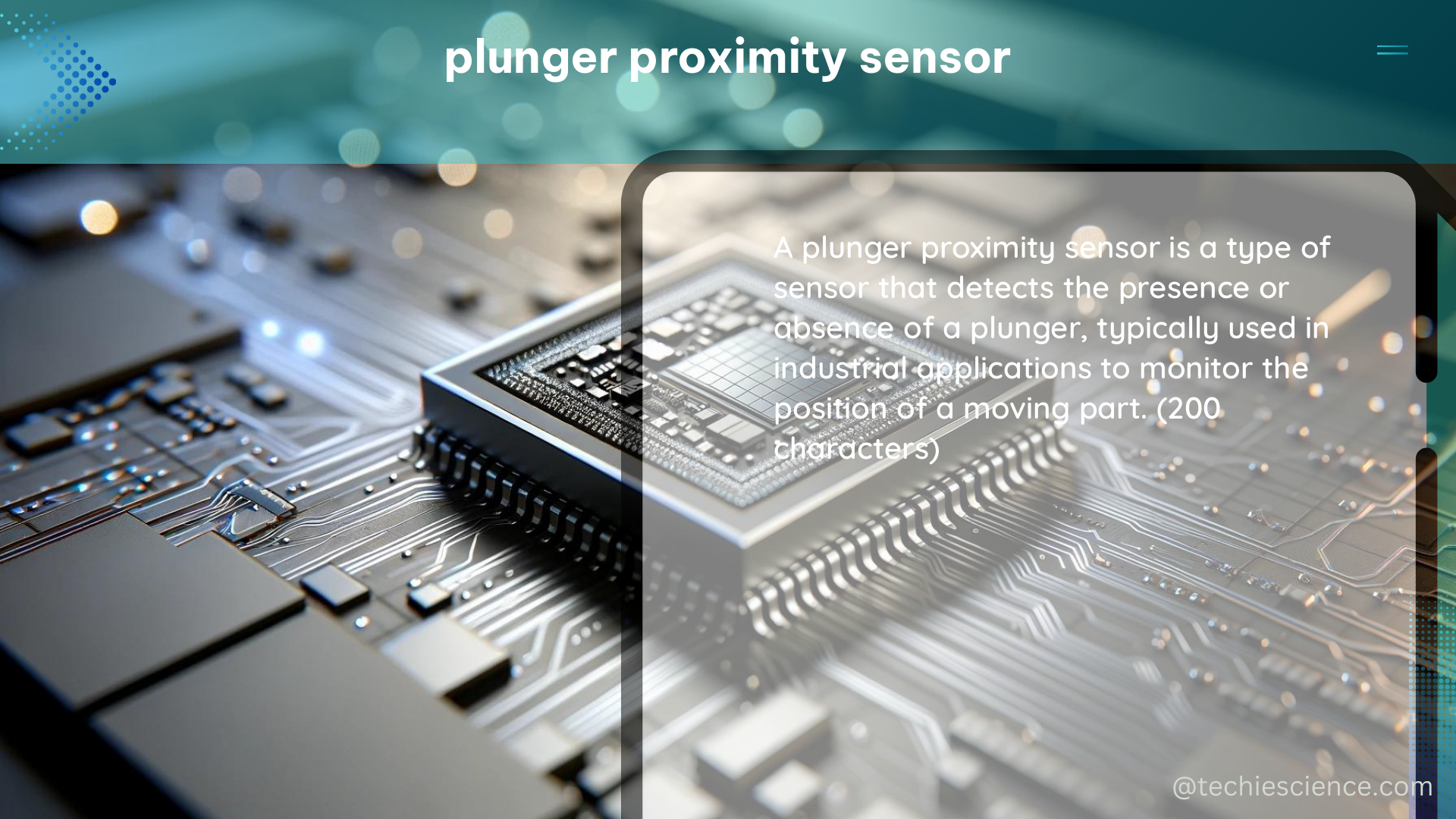A plunger proximity sensor is a type of non-contact sensor that detects the presence or absence of an object within its proximity, often used in industrial automation, robotics, and process control systems. The sensor emits an infrared or ultrasonic signal and measures the reflection or absorption of the signal to determine the distance to the object.
Technical Specifications of Plunger Proximity Sensors
The technical specifications of a plunger proximity sensor can vary depending on the manufacturer and model. However, some common specifications include:
Sensing Range
The sensing range of a plunger proximity sensor refers to the maximum distance at which the sensor can reliably detect the presence of an object. This can range from a few millimeters to several meters, depending on the sensor’s design and the type of signal it uses. For example, the VCNL4010 proximity sensor has a sensing range of up to 200mm.
Response Time
The response time of a plunger proximity sensor is the time it takes for the sensor to detect a change in the presence or absence of an object and output a corresponding signal. This is an important specification, especially in applications where fast response times are required, such as in robotics or industrial automation. The VCNL4010 sensor has a response time of 2.5ms.
Output Signal Type
Plunger proximity sensors can output different types of signals, such as analog, digital, or even wireless signals. The choice of output signal type depends on the specific application and the type of control system or microcontroller the sensor will be connected to. The VCNL4010 sensor outputs an I2C digital signal.
Environmental Ratings
Plunger proximity sensors are often used in harsh industrial environments, so their environmental ratings are an important consideration. These ratings can include factors such as temperature range, humidity, vibration, and IP (Ingress Protection) rating, which indicates the sensor’s resistance to dust and water.
Measuring Plunger Proximity Sensor Performance

To evaluate the performance of a plunger proximity sensor, several quantifiable data points can be used:
Accuracy
Accuracy refers to how closely the sensor’s measurements match the true value of the object’s distance. This is typically expressed as a percentage of the sensor’s full-scale range. For example, a sensor with a 1% accuracy rating would have a measurement error of ±1% of the full-scale range.
Precision
Precision refers to the consistency of the sensor’s measurements. This is often expressed as the standard deviation of the sensor’s measurements, which indicates how tightly the measurements are clustered around the mean value.
Repeatability
Repeatability is the ability of the sensor to produce the same measurement result when the same object is measured multiple times under the same conditions. This is an important metric for applications where consistent and reliable measurements are required.
Installation and Calibration
The installation and calibration of a plunger proximity sensor can also affect its measurement accuracy. Factors such as the sensor’s mounting orientation, ambient temperature and humidity, and signal interference can all impact the sensor’s performance. Therefore, it is important to follow the manufacturer’s recommendations for installing and calibrating the sensor to ensure accurate and reliable measurements.
DIY Project: Detecting Objects with a Plunger Proximity Sensor
As an example of a DIY project using a plunger proximity sensor, one could use the VCNL4010 sensor to detect the presence or absence of objects within a certain range. The sensor can be connected to a microcontroller such as the KL25Z or Arduino, which can then process the sensor’s output signal and trigger an appropriate response.
To set up the project, you would need the following components:
- VCNL4010 proximity sensor
- KL25Z or Arduino microcontroller
- Jumper wires
- Breadboard or PCB
The sensor can be connected to the microcontroller using the I2C communication protocol. The microcontroller can then be programmed to read the sensor’s output and perform a specific action, such as turning on an LED or activating a relay, when an object is detected within the sensor’s range.
Here’s an example of the code to read the VCNL4010 sensor using an Arduino:
#include <Wire.h>
#include <VCNL4010.h>
VCNL4010 proximitySensor;
void setup() {
Serial.begin(9600);
proximitySensor.begin();
}
void loop() {
int proximity = proximitySensor.getProximity();
Serial.print("Proximity: ");
Serial.println(proximity);
if (proximity < 50) {
// Object detected within 50mm range
digitalWrite(LED_BUILTIN, HIGH);
} else {
digitalWrite(LED_BUILTIN, LOW);
}
delay(100);
}
This code reads the proximity value from the VCNL4010 sensor and turns on an LED when an object is detected within a 50mm range.
By understanding the technical specifications, performance metrics, and installation considerations of plunger proximity sensors, you can design and implement effective DIY projects that leverage these versatile sensors in a wide range of applications.
References
- MIT App Inventor Tutorial – Proximity Sensor, Distance Detector (https://www.youtube.com/watch?v=kdnpgyWqLJU)
- Non-intrusive sensor system – Google Patents (https://patents.google.com/patent/RU2671606C2/en)
- Movement detection across a proximity sensor array? – Edge Impulse (https://forum.edgeimpulse.com/t/movement-detection-across-a-proximity-sensor-array/1609)
- Plunger Setup (VCNL4010 Proximity Sensor) – Pinscape Build Guide (http://mjrnet.org/pinscape/BuildGuideV2/BuildGuide.php?sid=VCNL4010)
- Proximity Sensor Suggestion | PLCS.net – Interactive Q & A (https://www.plctalk.net/threads/proximity-sensor-suggestion.127046/)

The lambdageeks.com Core SME Team is a group of experienced subject matter experts from diverse scientific and technical fields including Physics, Chemistry, Technology,Electronics & Electrical Engineering, Automotive, Mechanical Engineering. Our team collaborates to create high-quality, well-researched articles on a wide range of science and technology topics for the lambdageeks.com website.
All Our Senior SME are having more than 7 Years of experience in the respective fields . They are either Working Industry Professionals or assocaited With different Universities. Refer Our Authors Page to get to know About our Core SMEs.